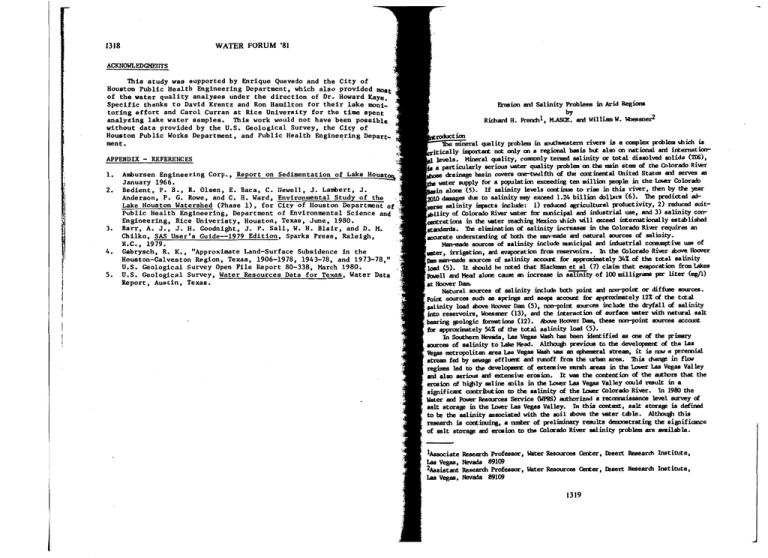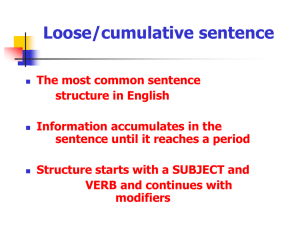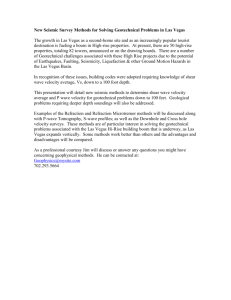Document 10530021
advertisement

1318 WATER FORUM '81 ACKNOWLEDGMEUTS This study was supported by Enrique Quevedo and the City of Houston Public Health Engineering Department, which also provided moSt of the water quality analyses under the direction of Dr. Howard Kaye. . Specific thanks to David Krentz and Ron Hamilton for their lake moni_ toring effort and Carol Curran at Rice University for the time spent analyzing lake water samples. This work would not have been possible without data provided by the U.S. Geological Survey, the City of Houston Public Works Depattment, and Public Health Engine~ring Depart_ ment. APPENDIX - REFERENCES ! I, I ;1 fi , ,. 1. Ambursen Engineering Corp., Report on Sedimentation of Lake Houst~ January 1966. 2. Bedient, P. B., R. Olsen, E. Baca, C. :lewell, J. Lambert, J. Anderson, P. G. Rowe, and C. H. Ward, Environmental Study of the Lake Houston Watershed (Phase I), for City of Houston Department of Public Health Engineering, Department of Environmental Science and Engineering, Rice Univeristy, Houston, Texas, June, 1980. 3. Barr, A. J., J. H. Goodnight, J. P. SaIl, W. H. Blair, and D. M. Chilko, SAS User's Guide--l979 Edition, Sparks Press, Raleigh, N.C., 1979. 4. Gabrysch, R. K., "Approximate Land-Surface Subsidence in tbe Houston-Galveston Region, Texas, 1906-1978, 1943-78, and 1973-78," U.S. Geological Survey Open File Report 80-338, March 1980. 5. U.S. Geological Survey, Water Resources Data for Texas, Water Data Report, Austin, Texas. Erosicn ani Salinity Prob1ens in Arid by Richard H. Freodl l , M.A5O':. ani Resions willismW. '-bes~ qJ8lity Jrob1em in IDUl:hwestern rivers is a ~1ex p:-ob1em.bich is 00 a regional basis bU: also 00 national ani iocernatiDn­ levels. Mineral qJ8lity, camonly tened alinity or total dissolved solids (TOO), a particularly serious water quality problem on the main stem of the Colorado Riw.r drainage basin oavers one-twlftb of the centinen:al United States ad selVes as supply for a populatial exceedi'l?; ten mi11ial people in the Inwer Colorado (5). If salinity levels centime to rise in this river, then by the ~ dIE to salinity usy exa!ed 1.24 billim dollars (6). The p:-edicted ad­ hqacts include: 1) reduced agricultural Jroductivity, 2) reduced suitof Colorado River water for 1IUlicipal ani iniustrisl use, and 3) salinity carr in the water reaching Mexico .nich will acceed internationally estlblished The eliminatial of salinity increases in the Colorado River requires an mderstaRling of both the llBIHDIKIe ani natural 8OUl"ceB of salinity. sources of salinity include 1IUlicipal ani· inlustrial coramptive use of , irri88tion, an evaporation frau reservoirs. In the Colora:!o River d>ove HooIrer DIID.--made sources of salinity accomt for approxiaBte1y 34% of the tocal salinity load (5). It Ihluld be Itted that Blad<DBrl et a1 (7) claim that eYapOration fran Lakes J\:JWtell and Mea:! alone ca.tse IKl increase in salinity of 100 milligrans J2r liter (~l) at Hoover Dam. Natural sources of alinity include both JXlint ad ncn-poioc or diffuse sources. PoirE sources sum as springs ani BeEP! acc:omt for approxiuately 12% of the toca1 "linity load dxNe I!ocM!r Dan (5), non-point a:xarces include the dryfall of salinity into reaervoirs, Woessner (13), ani the interaction of surface 1iIlter with natural salt ,. bearing l'J!ologic mmatials (12). IbcNe Hoover Dam, these non-point sources ccamt ~ b' approximately 54% of the total salinity loai (5). In Southern Nevada, Laa Vegas Wash has been identified as roe of the Jrimary toUrces of salinity to Lake Mead. Althru&Jl Jrev:ious to the developllJi!OC of the Las Vegas netropolitan area Las Vegas Wash 1iIlS IKl Ephemeral stream, it is row a p!remisl stream fed by -(IIi! effllEOC ani rmoff frClll the urban area. This ~ in flClll regimes led to the development of sters ive JlBrsh areas in the Lower Las Vegas Valley an! also aeriws ani e)CI:ellBive erosim. It _ the contential c£ the autoors that the erosion of b~ly ..line lDils in the Lower Las Vegas Valley cruld result in a sigpific.-: contributial tIl the salinity of the Lower Chlorado River. In 1980 the Water an Power Resources Service (WpRS) aJtborized a recmnaisaance level survey c£ I8lt storal!lil in the Lower Las Vegas Vallay. In this context, salt storal'J! is defined to be the salinity associated with the soil move the MIter tlb1e. Alt:h0u3t this research is continuing, a t1.II1ber of ]ll"eliminary results deaDratrat~ the siFificance of ult storSlJ! an erosWn to the Colorado River salinity Jroblem are_ilable. m.xm:--= rd: only 1Aaaociate Laa Vegas, 2Assistant Laa Vegas, Research Professor, Water Resources Center, I2sert Research Institute, Nevada 89109 Research Professor, Water Resources Center, I2sert Researm Institute, Nevada 89109 1319 Salt Storage in the I.o.er Las Vegas Valley The Lower Las Vegas Valley lies within the Basin ani ~ Province, an:! the topograp\y is diaracterized by sulr-paral1el nountain ranges with a central bain lIDdi­ fied by eI'C"oaching alluvial fans. The total relief in this valley is 10,700 feet. The surrotJDdiq: 1I1lUXlI:airB are c~ed of Paleozoic carbonates and Tertiary wlcanic:a. las Vegas Wash is Ibe reaaant of a t:ereonial. flow referred to as the pluvial Las Vegas River Iohich was active 30,000 years before pr-esent (B.P) (1). The draina~ !!It­ terrled fran Indian Spr-ings, Nevada to the Coloralo River Wlich is a distance af 70 miles. Evidence suggests either marshes or shallow lakes occurred in the basin frQII 30,000 to 15,000 years B.P. an:! stream flow \095 again active antil 6,000 years B.P. Subsequently, decreased precipitation ani spr-iq; flow am increasiq; aridity resulted in an ephenera 1 drainage 0, 10). Becauae ooly limited resources COJld be mlicated to assessq the new ard COItto­ versial concept of salt storajlJE!, a small study area 12.27 square miles in extel'lt _ defined in the Lower Las Vegas Valley near Henr:lersoo (Figure 1). Within this area, 38 ~le sites wen! defina:l aloq; lines Iohich were selected to provide a maxinun 8IIDImt of infonuation at a miniuun cost. At each Slllq)le site, a iDle \095 lU~red fran the grourrl surface to the water table, am soil ~1es wen! taken at the surface, one-balf foot, one foot, am then at one fuot intervals to ten met. Below ten feet, SllJt)1es were takal at t10D foot intervals mt: il the water tab Ie was reached. '!he soil smq>les -were analyzed by stamartl AS'lM metiDds to d!!temine the soil lIDisture, am the mass of rea!!IY soluble salts associated with the soil was d!!temrined by a pr-ooedure d!!veloped by Desert Researdt Inst itute. '!he Dethodology used was: 1. Thirty gram of <M>Il dried soil was placed in 1,500 milliliters of distilled water - a 50: 1 dilution ratio - an:i the container WlS tiWttly capJ:ed to prevent evaporation. 2. Fach S811ple bet tIe was Slaken for 30 secon:ls at 30 mimte intetVals, a minima of four times. 3. After 24 hours, the electrical coniuctivity af the supematert: ~le liquid was oeasured, ani the total dissoh/eli solids present were calw1ated fran the electrical ccnlud:ivity usiq: a calibration curve d!!veloped for the study area. This laboratory Jrooedure determined the salt cootent of the ooil in tetIM of the 6uaas of salt) J:er (mass of dry soil). It is noted that this procedure yields estimates of soil salinity Iohidt are sligl:ttly h~ than the estimates WI idt result fran the aetiDd recClllll!llded by WPRS (4). 1bweIIer, both of these procedures are based <XI the SBIre pr-in­ cipals am an EIIl'irical relationship between the rretiDds can be d!!fined for the sllJdy area. 'Jhe S811pling am laboratory Jrograns resulted in a three dimmsional arrlq of salt stor. values for the sllJdy area. Since the soil saq>1es were talcen at definite depths below the grOlfti BUrface, salt starage is actually d!!fined 00 a set c:I. planes parallel to the grourd BUrface. For ruoerical conwni.ence. salt star. is by defini­ tion 22ro at all Slllq)le locations Wlidt are below the loBter bble. It is trted that this COI'M!Iltim does net contradict the definition of salt stara~ ani results in 38 values of salt star. being d!!fined 00 fNery plane. '!he salt in star. beboeen any t\oIO aljacent planes can then be d!!tetmined by nuaerical integration. If salt star. was defina:l on a regular cartesian PTid with a camr:n origin in each plane, then a very siq>le integration schene could be used. lbw­ ever, as trted p:eviously, the S8II1>le site locations ~ chosen to JrQllfide information aloq; "arbitrary" lines rather than to provide R.JDerical data Wlidt could be easily intePTated. 1herefore, it was necessary to use a bicubic spline U£erpolatq netrod to interpolate values of salt stor. onto a regular cartesian grid, Foley (8). This uethod of analysis used the given field data to estimate salt starage values a:Eo a 33 x 33 cartesian grid in each plane. 'lhen, the salt in stora~ beboieen any t10D adjacent 1321 ARID REGIONS PROBLEMS WATER FORUM '81 1320 ~ 111 ~ '" ~ u • >'g ~~ - ...0;3,..: - -- U .....B'tl ~ .. 111 8 '" 3~ u~ ti '" ~~ .... 0 .. § Q) i :J: *}. 0:>";)-1, .\ .\ -f>\ " ... ° Gi~ ..... >O+' ....U ....111 ~~ :> Ul '" u ~!i! u :>i;' '" ~ I-< U ,'j~ ~\ \_.,. U 01 ~ ~ .:iB utn SI-I ti ...... III ...... tnQI Qlti ~ O>'tl .~ ~ 1324 WATER FORUM '81 ARID REGIONS PROBLEMS fum of stream bed lEgradation ani helkl cutt~. lEGS suspen:led sedinent data inlicate that at an avera!!J! daily disdu!rtJ! of 82 cfs pe: day 240 tom per day of sedUrem: _ being rencved in 1978. Thus, on the aI1erage, 88,000 tons d sedinent: are n!DO\Ied fraa the Lower Las Vegas Valley in a year - an estimate basal 00 suspende:! sedilmnt data. flash flood events also reuDIIe s~ificant aIO\.IltS of soil. In FEbruary, 1976 an instancaneous suspeada:l sedimatt lo1kl of 28,000 tons per day was llEasure:! at a fl.w rate of 620 cfs. A large flow event in July, 1975 (Q • 2,400 cfs) eraled 1.3 million cubic feet of material or approximately 43,000 tons of soil in the Lower Las Vegra Valley. Beboeen August, 1975 ani April, 1979 flood events ani the increased perennial flow in Las Vegas Wash have eroded 16 mill ion cubic feet of dumnel material or aplX'axiaate­ ly 535,000 tons of soil. Beboeen August, 1975 an:! April, 1979 the Las Vegas Wash heaJ­ coc hs:l advanced at an avera!!J! rate of feu: feet per day ani eroded dumnel material at an average rate cI 12,860 cubk feet (430 tons of soil) per day. It is rrte:! that this last erosim rate is sigpificantly larger thal the estimate lErived fran the suspended sediJren: data. Although future rates of erosion will be plrtial1y detemrine:l by the geology of the area, there is no reason to expect that the actual 8IIDll1t of JI!lterial eroded will decrease as the main stem era;:ion SlX'es:ls to the tributary channels; in fact, the amunt of erosioo III!I!f increase. Erosion - Salt Storage Interactions The mregoLng IlIlterial has lEfine:! both salt storage in t:hP. Lo!.Er Las Vegas Valley ani the erosim 10bich is occurr~ along Las Vegas Wash in this area. Although it has always been a::cepted that the erosion cI saline soils contributes to the Coloraio River salinity problem, this researdl is to the authors' koowled!!J! the first irstance in 10bkh a::curate data regarding this situation are available fur the Lo!.Er Colorlklo area. USGS records for Las Vegas Wash at North Shore Roa1 indicate that duri~ ~ter }'ear 1978 the average flow was 82 cfs, the aver. salinity concentration WlS 2,574 mg/l ani the average sediment concentratioo was 1,086 mg/l. nus duri~ this tine period appradmate1y 210,000 tons cI salt ani 88,000 tons of sediDent loB'e ex:porte:! fran the Las Vegas Valley to Lake Mea:! by Las Vegas Wash. The interrelatiorEhip betlieen the salt storage cmcept ani erosion is summrized in Table 1 under the asS1.llqltion that the 12.27 square miles of study area soila are repr~ati'W of the sedinent being tramported in Las Vegas Wash. It is realized that if I.IIS8.turated soil becanes saturate:! during precipitation ani flood events prior to physical erosioo, salts may be renDVed by leaching. 1he jhyskal displacenent ani transport of a given wltme of soil _ utilized in this study to calculate the salinity load~ by the Las Vegas Wash to the Colondo River. Table 1: Depth I>I'Y'j!,e ~D, ft (I) <Kl.5 (}-l. (}-S. 0-24. I ~~so 1.710 3.421 17.10 82.10 x x x x 108 loB loB loB 9.47 x loS 16.1 x loS 53.6 x loS 107.2 It loS 5.66 x 106 13.3 x 106 56.6 x 106 271. x 106 0.167 0.142 0.09!.7 0.0396 14,700 12,500 8,330 3,480 Table 1 shoIoB the CCJI1IU:atim of a r8ll!!J! cI different estiDates in colunn (6) that would result fran the erosion cI differem: total depths of soil as stm.n in colum (1). Colutn (2) shoos the velure of the study area fur each specifie:! total depth, and £ ~ ! jI O:lqlutatioo. c:#. Salt Eroded fran the Las Vegas Valley Awrage Salt Transported to Volure Salt Store:! Soil in Coloraio River CorrespoqHng Ratio Via Eros:iDn, intoD VolUle to 1$), ~ TDns/Year M"a, 'lbns ~'4)Tons (2) (3) (6) 1325 colum (4) sho.s the estinated total ~~t of the soil in the study area based Ql an specific we~t of 66.1 pounds per cubic foot. ColUllll (3) is the estinnte:! total we~t of the salt in the study area basal en the corrluctivity aeasurf!lll!nts ani analysis describe:! in the forego~ material. Colunn. (6) is ol:t:aine:l by uultiplyi'll the amual suspended sediment load, 88,000 tons, by the salt to soil ratio, colum aaa-l (5). Although not all of the sedhrent plsS~ the U&;S gage used in this analysis cares fran the Lower Las Vegas Valley, 96% of the sediaent pass~ this ga~ does care fran the salt storage area. 1he estiDates in Table 1 are very corBeNatille since the salt storage in the vicinity of Las Vegas Wash is nuch higJler than it is in the reminder of the study area. This is illustrated in Figure 3 in \ohkh the thim dUrension is salt storage in milligrans of salt per kilogram of dry soil. Thus, it is conclude:! that, depending on lhere the sediJrmt being ernded is locate:! in the soil wham, as nu::h as 7% to as litt le as 2% of the total salinity enteri~ the Coloraio Riwr S)1StElli fran Las Vegas Wash is attributable to erosion. lEGS reconls also dem:mstrate that in the reach of Las Vegas Wash 10bich passes thrrugh the study area the annual increase in salinity transport is 74,000 tons. If ooly this reach is considered, then erosion my accamt: fal: as rrudI as 20% of the salinity increase. In the case of extrEm! flow events, the contribution of erosion to the salinity prc:blan is even mre sigpificant. For E!XIIIJ1Ile in Las Vegas Wash the July 1975 flow event \oh ich renrnred 43,000 tons of so it also renoved between 1,720 to 7,300 tons c:i salt. Also, between August 1975 and April 1979 betlieen 21,000 and 91,000 tons of salt was reaoved. In <:>aq>arison it is noted that BId!! Sjr~S near the IlDUth of the Little Colorado River an:! consiclere:! the largest point souroe of salinity in the ea:ire Colorado Riller Basin (5) contributes 518,000 tons c:i salt per }'ear to the Colorlklo River System. In s:Idit ion to the salt storage study, described here in 8CJI1le lEtail, the Water Resources Center has also analyze:! the aolocion-salt lolkli~ effect of flash floods on the salinity jrob1em in mur arid, e;nemeral, I.IIdeveloped ~tersheds tributary to Lake Mead. Woes= (I3. 14). This study ~ covered 192 square miles in W'oich ei3tt intennittent flow events ..ere recotded am Slllq>led in 1978 and 1979. 1he estimlte:! disdiarge of flash flood water was 1,700 acre feet in 1978 and 71Jl a:re feet in 1979. The average 100 of these .mers r~ fran 1,270 to 2,000 mg/l. Based on these data, it is =lude:! that 3,000 ani 1,300 tons of salt entere:l the Colorado Riwr S)'Stan fran the 192 square mile study area at rates of 16 tom per square mile per }'ear an:! 6.9 tons per square mile per year in 1978 ani 1979, respectively. 'lbese data lem addit ional support to the B.lthors content ion that ercs ion is a corEr ibutor of sal inity to the 0>1orado River system. Coaclusion Based 00 the p-eliminary results of salt stor~CI!I:iDn analyses ani flash flood salinity loading work, it is conclude:! that erosim contributes to the salinity JrOblElli in the O>loraio River System. .Analyses c:#. salt storage dsta revealed that 2% to 7% C£ the total salt balance fur the Las Vegas Wash can be attribute:! solely to erosion. Analyses of data indkates that eros:iDn my account mr 2at of the salinity increase recorded fO[' the read! of Las Vegas Wash 10bidl passes thraJl!Jl the study area. These results highlight the sigpificance of asaess~ potential national salinity control measures with cooplete salt balance infOtllllltioo. Additional erosion-salt loadi~ eYIllut ions are necessary. Acknowledgpmt:s 'Jhe research described in this plper WIll support:e:! by the Water aU P~r Resources Servioe (<Kl7-30-Wl26) ani the Bureru of Lard Manageuent (YA-512-cr-200). The aJl:hors also wish to acknowledge the aid ani aivice of !Bsrs. Robert Barton ani D.A. 1\ml of the Water ani Power Resources SeNke, Boulder City, Nevada. WATER FORUM '81 1326 ~') 1. _ _, ''Las Vegas Wash Interim Report No.2, Water ~lity Series: Clarlt Comty 208 Water ~lity Mmagemmt Plan, Clark fruity, lievada, las Vegas, Nevada," IllS 0,., Las Vegas, Nevada, 1977. SALT-RELEASE FROM SUSPENDED SEDIMENTS IN THE COLORADO RIVER BASIN 2. , ''Soil Smvey: las Vegas ani Eldorado Valley Area, tevada," U.S. D!part\ll!Jll: of Agriculture, Soil ConseNation SeNice, Washingtm, D.C., 1967. 3. , ''Caq>rehensive Plan: Task 1 - Existing Con:litions," Clarlt Grunty of ~emive Planning, Las Vegas, Nevada, 1980. 4. , Earth Hanus1, U.S. IEp8rtment of the Interior, Water ani Power Resources Service, Secoal edition, Washingtm, D.C., 1974, pp. 44&450. 5. , '''Ihe Mineral QJality Problem in the Q)lorado River Basin: Stm!ary Report " U:S:-Env:i.ronnental ProtectUln ~y, Washingtm, D.C., 1971. ' 6. Iepart\ll!Jll: Abstract , "River Water QJality 1mpr0ll8lElll: Prq;ran," U.S. Iepartment of the Interior iiUreiU of Reclanation, Washingtm, D.C., 1974. ' 7. Blackman Jr., W.C., Ibuse, J.V., Schillinger, GoR., ani Shafer Jr., W.H., ''Mineral Pollution in the Colorado River Basin," Journal of the Water Pollution Control Federation, Vol. 45, No.7, July, 1973, pp. 1517-1557. 8. Foley, T.A., ''Canpocer-Aided Surface Interpolation and Gr~ical Display," Ile!ert Research Inst itute, Water Resources O!nter, Reno, lievada, in press. 9. Maxey, G.B. an:! Jameson, C.H., "Geology an:! Water Resources of Las Vegas and ~ an:! Indian Springs Valleys, Clark an:! Nye frulties, Nevada," State of Nevada Water Resrurces aJlletin, No.5, 1948. --­ 10. Mifflin, M.D., p!rsonal CQIIIlmi.cation, February, 1981. 11. Patt, R.O., ''Las Vegas Valley Water Budget: RelatioIllhip of Distribl£ion, Oxls~ive Use, ani Recharge tD Shallow Groondwater," EPIt-6OO/2-7IH59, U.s. F.nY:i.ronnental ProtectUln At!J!:ncy, Washingtm, D.C., 1978. 12. Riley, J.P., Bowles, D.S., OIadwick, D.G., ard Grenney, W.J., "Preliminary Identification of Price Ri1let' Basin Salt Pick-up and TratlSport Processes," Water Resources aJlletin, lmerican Water Resources Association, Vol. 15, No. 4, ~ 1979. 13. \obessner, W.W., ''Reconnaissance Evaluation d Water QJality - Salinity lDading Relationships of Intetmittent Flow Events in a Desert F.nYircnnent, Las Vegas, Nevada," Water Resources Omter, Iesert Researm Institute, PUblication 44021, Septl!lliler, The release of salt from auspended sediments has been identified as a diffuse source of salinity in the Price River, which is a major contributor of salinity within the Upper Colorado River Basin. This paper describes experimental studies for identifying the controlling factors for this salinity source. Soil samples, including channel material were taken from the study area. These aamples were mixed with water and the change in electrical conductivity of the solutions was monitored. The dilution, particle size fraction, mixing velocity, initial electrical conductivity, and the saturation extract electrical conductivity were all varied and were found to be important factors controlling the rate of salt release. The Buckingham pi-theorem was employed to develop empirical equations for predicting the electrical conductivity of a sediment-water solution based on the controlling factors listed above, and were verified with additional laboratory data. Introduction Control of the rising salinity levels in the waters of the Lower Colorado River is becoming economically and politically desirable (1). Because of this there exists a pressing need to better understand the major processes and causes of salinity in the Colorado River Basin, thus creating a foundation from which the necessary salinity reduction techniques might be developed. Failure to do so may result in damages as high as 1.24 billion dollars (2) of lost agricultural production in the U.S. and Mexico, and also in reduced utility of Colorsdo River water for municipal and industrial uses. Field data have indicated that constituent salt associated with fluvial sediments is an important diffuse source of salinity in the Price River (2), and consequently, in the Colorado River. The Price River exemplifies the diffuse loading conditions of the upstream area of the Colorado River basin. Relatively high quslity flows originate in the mountainous areas with an average TDS (total dissolved solids) of less than 500 mg/l. Water quality of 1980. 14. 1blssner, W.W., "Intemri.ttent Flow I!lI7enI:s - Salinity lDadilll Relationships in the Lower Colorado River Basin, Southern Nevada," Hydrology ald Water Resources in Arizona an:! the Southwest, Arizcoa Sec. IWRA, 1bcson, Arizona, Vol. 10, 198>, pp. by Hooshang Nezafati l , David S. Bowles 2 , A.M., ASCE and J. Paul Riley3, M., ASCE I09=U9. lCr-ad-uate- Re-s-earch Assistant, Utah Water Research Laboratory, College of Engineering, Utah State University, Logan, Utah 84322. 2Research Associate Professor, Utah Water Research Laboratory, College of Engineering, Utah State University, Logsn, Utah 84322. 3professor and Head, Division of Water Resources & Hydrology, Depart­ ment of Civil and Environmental Engineering, College of Engineering, Utah State University, Logsn, Utah 84322. 1327 .J





